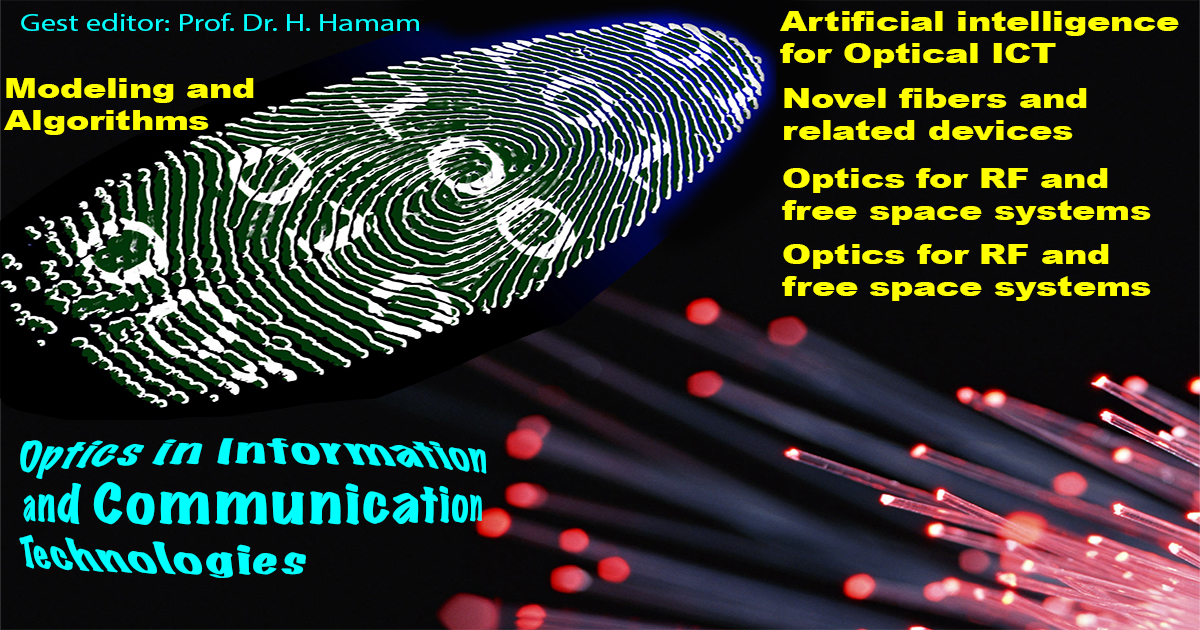Optics in Information and Communication Technologies
A special issue of Applied Sciences (ISSN 2076-3417). This special issue belongs to the section "Optics and Lasers".
Deadline for manuscript submissions: closed (20 June 2022) | Viewed by 17698

Special Issue Editor
Interests: optical telecommunications; wireless Communications; diffraction; fiber components; RFID; information processing; data protection; deep learning
Special Issues, Collections and Topics in MDPI journals
Special Issue Information
Dear Colleagues,
This Special Issue is devoted to the new trends in optics applied to Information and Communication Technologies (ICT). This issue aims to host original, unpublished, and breakthrough concepts in optics that make use of new tools and mechanisms, such as artificial intelligence, to solve complex problems for applications in ICT.
Optical systems use communication and information processing. To name a few large fields, we enumerate telecommunications (fiber optics, etc.), information processing (optical and quantum computing, etc.), sources of light (VCSEL, etc.). The Special Issue will cover but is not limited to:
Artificial intelligence for optical ICT
- Predictive maintenance;
- Traffic prediction;
- Network planning and optimization;
- Traffic prediction and classification;
- Quantum cryptography;
- Optical front-haul and back-haul supporting 5G/6G;
- Machine-learning-based DSP for optical transmission;
- Etc.
Novel fibers and related devices
- Light propagation in optical fibers;
- Optical fiber design and fabrication;
- Fiber-based devices;
- Multicore fibers;
- Fiber amplifiers;
- Diffractive elements;
- Etc.
Optics for RF and free space systems
- Microwave photonics;
- THz photonics signal generation/detection;
- Optics-based THz wireless systems;
- Optical wireless communication;
- LiFi and VLC;
- Satellite photonic communication links;
- Etc.
Architecture and management of optical communication systems
- Control, orchestration, and management of optical communication systems;
- Optical network architectures, design and modeling;
- Planning and scaling of hybrid optical/optoelectronic networks;
- Network reliability, survivability, security and disaster recovery;
- Etc.
Modeling and algorithms
- Algorithms for DSP in optical ICT;
- Modeling, design, and implementation of digital signal processing;
- Reduced complexity DSP algorithms;
- Optical MIMO DSP;
- Etc.
Prof. Dr. Habib Hamam
Guest Editor
Manuscript Submission Information
Manuscripts should be submitted online at www.mdpi.com by registering and logging in to this website. Once you are registered, click here to go to the submission form. Manuscripts can be submitted until the deadline. All submissions that pass pre-check are peer-reviewed. Accepted papers will be published continuously in the journal (as soon as accepted) and will be listed together on the special issue website. Research articles, review articles as well as short communications are invited. For planned papers, a title and short abstract (about 100 words) can be sent to the Editorial Office for announcement on this website.
Submitted manuscripts should not have been published previously, nor be under consideration for publication elsewhere (except conference proceedings papers). All manuscripts are thoroughly refereed through a single-blind peer-review process. A guide for authors and other relevant information for submission of manuscripts is available on the Instructions for Authors page. Applied Sciences is an international peer-reviewed open access semimonthly journal published by MDPI.
Please visit the Instructions for Authors page before submitting a manuscript. The Article Processing Charge (APC) for publication in this open access journal is 2400 CHF (Swiss Francs). Submitted papers should be well formatted and use good English. Authors may use MDPI's English editing service prior to publication or during author revisions.
Keywords
- artificial intelligence for optical ICT
- novel fibers and related devices
- optics for RF and free space systems
- architecture and management of optical communication systems
- modeling and algorithms





